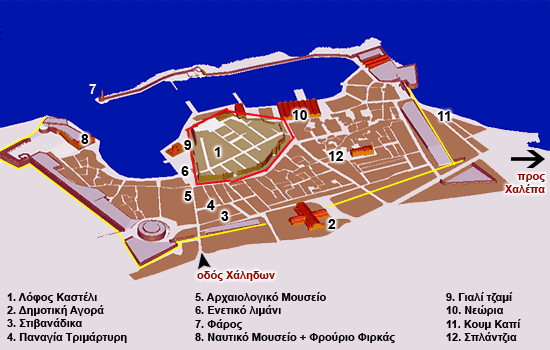About Chania

New town of Chania
You could say that Chania consists of two towns, the old and the new, which coexist in a harmonious whole. The new town embraces the old and spreads outwards ever wider. Its layout is fairly good near the centre and it’s easy to find your way around. Unfortunately this changes in the suburbs, where it’s easy to get lost. It is commonly observed that its is very easy to find your way into Chania but much harder to get out. Of course, you may not want to leave, as Chania is a city that will enchant you.


Chania old town
The heart of Chania is still the old town, with its narrow, labyrinthine alleyways and listed buildings dating from different periods, where you can enjoy romantic strolls. Many of these buildings have been turned into small hotels, restaurants, shops or homes.
Don’t hesitate to wander round the alleys of the old town, looking for the lovely images that await you. Your camera must be your inseparable companion, as Chania is one of the most-photographed cities in Greece.
The old town stretches out parallel to the Venetian harbour, from Firkas Fortress and the Maritime Museum to the “Pyli tis Ammou” (Gate of the Sand, or Koum Kapi in Turkish) to the east of the arsenals. This is the part of town within the Venetian walls and includes Byzantine Chania, once enclosed within less extensive walls.
The Byzantine walls protected the fortress of Kastelli, the hill which was first inhabited in the Neolithic period.
Kastelli Hill rises above the Turkish mosque in the Venetian harbour. Here stood the acropolis of ancient Kydonia, the Minoan Chania. There, too, was built the first Byzantine fortress, the Kastelli, surrounded by walls with many towers and bastions. The Venetians established their headquarters there in 1252, building the Rector’s Residence (the Rector was the Governor of Chania), while the same site was the seat of the pashas during the Turkish Occupation. During the last years of Turkish rule, the Christian aristocracy lived inside the Kastelli. Unfortunately most of the district was destroyed by bombing during the Second World War, and its medieval aspect was lost forever. Today only the base of the north wall remains. There is also the main road that once ran through the Kastelli, modern-day Kanevaro Street with its imposing mansions.

The old town of Chania is surrounded by the Venetian walls, marked with a yellow line.
The much smaller Byzantine walls (red line) defended Kastelli Hill.
Tour of Chania
Our tour of Chania will start at the Municipal Market in the centre of town. We will then enter the old town and head towards the Venetian harbour. We will walk the length of the harbour to the Gate of the Sand and return through the alleyways of the Splantzia to our starting-point. Of course this tour is only intended to give you a rough idea, and it would better if you did it in sections over two or more days, so you can take your time.
- Chania Municipal Market
- Stivanadika
- Chania Cathedral of Panagia Trimartyri
- Archaeological Museum of Chania. After visiting the museum, continue down Halidon Street to Sindrivani Square in the Venetian harbour. From here you can walk left along the jetty to the Maritime Museum.
Alternatively, after the museum turn left into Zambeliou Street and stroll along it, enjoying the magic of the alleyways of the old town. Walk right down Zambeliou Street, continue along Theotokopoulou Street and turn right into Angelou Street until the Maritime Museum. - Venetian harbour
- Maritime Museum of Chania, the Firkas Fortress and the Topanas district.
- Yiali Tzami, the Turkish Mosque in the Venetian harbour of Chania
- Venetian Shipyards or Arsenals
- Koum Kapi
- Splantzia, from the Splantzia you come back to the Municipal Market, where we began our tour of the old town of Chania.
- Chalepa: the district of Chalepa is at the eastern limits of the town and it would be best if you visited it separately as it is quite far. For example, Eleftherios Venizelos’ house is about a kilometre from Koum Kapi.
- Venizelos Tombs on Akrotiri
By clicking the link below you can find more information about the city of Chania.
